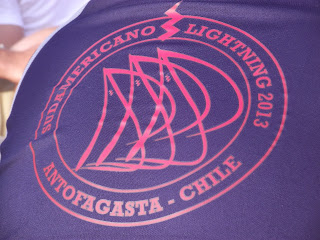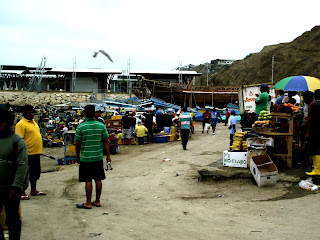It's been a week of cool happenings, starting with a run out to Montañita, a village about an hour up the coast, to check out the surfing vibe and have a yummy lunch. And ending with a surprise visitor in our bay late yesterday...
In the 5 weeks we've been in Salinas, we have not once wakened up to sunshine. Every day has dawned with heavy grey overcast skies, even though the temperatures are relatively warm. But...on Wednesday last week (Miércoles - Wednesday), lovely morning sunshine to waken us up!
And..it lasted all day! We even had a sunset! Just a tease, a taste of things to come...but delightful. We savoured it on our way up la Ruta del Sol (highway E15, good road!) running alongside miles and miles of beautiful empty beaches. This highway runs about 750 kilometers from Salinas north to the Esmeraldas and the coast of Colombia, and crosses the Cordillera Chongon-Colonche - one of the two major mountain ranges west of the Andes - covered in indigenous wet rainforest. We'll get up there in the next few months, so more on that another time.
But today, our trip goes as far as the charming surfer village of
Montañita, which was relatively undiscovered until it finally made it onto the map as surfers from all the world were drawn there. And they are followed by every nationality of tourists to experience the beauty and the unique vibe of the place. We were there on an off-season Wednesday, just for the day - but even so we had a sense of what the weekends must be like, especially in high-season, and February's Carnivale - streets packed with fun.
The beach village is all about winding narrow streets with unpretentious colourful shops and restaurants, music everywhere (often reggae), hostels and small bright hotels.
The beach itself is spectacular - I'm almost getting tired of over-using that word...can we invent a new one?
 |
| Tiki Limbo for lunch |
Leisurely lunch at
Tiki Limbo (link), where one can choose a table-topped mattress, which looked so comfortable. Ideal for spending a few hours with a laptop..or a hookah perhaps (yes, I do mean a pipe). Meals are between $8-15, portions huge, and selections an eclectic mix. Beers the usual $1.50 - $3. We sat in comfy, cushioned booths and had burgers with tasty variations. Recommend it, and feel pretty sure there are no bad choices on this menu.
 |
| THAT'S what I'm talking about! Oceanside ceviche and cervesa! |
 |
| Delicious corn/chicken fritters for sale on bus |
Travellers from many countries can enter Ecuador without a visa for up to 90 days. To stay longer, one has to arrange for a non-Immigrant visa which can extend the stay up to 180 days. Although we could have acquired the document by taking 3 trips to the Ecuadorian Embassy in Toronto before we left Canada, we had decided to apply once we arrived in-country. This must be done at the Ministry of External Relations in Guayaquil, the country's largest city - the one we flew into on our arrival - and about 2.5 hours away by bus. So, now we know we do want to extend our stay, off we go to undertake the venture.
 |
| Coming into Guayaquil - sprawling city |
 |
| Business centers in Guayaquil |
 |
| Ministry of External Affairs, Guayaquil |
The little Salinas bus station that was a 20 minute walk from us has now closed, so we have to take a longer local bus or cab to Ballenita, to the brand new Terminal Terrestre de Santa Elena - the central terminal for the Santa Elena region. A $5, 20 minute cab ride. Really nice bus station! $3.30 each for an air-conditioned coach ride into the city. The Terminal Terrestre in Guayaquil is very close to the José Joaquín de Olmedo International Aiport - easy-peasy for our travel home in (we hope!) April. And from the bus station, a quick ride by cab to the very impressive glass government building, where we took a ticket, waited for 10 minutes only in the large, cool hall, and obtained the 'real deal' on what is required to apply for the visa. We've google'd this to death. We've talked to umpteen people here, and really didn't know what to expect. 'It changes frequently', 'Very complicated' to 'simple', and 'you will need a criminal record check from your country', and a 'health certificate from a local doctor' - that we would 'probably be best to hire a lawyer'. 'Get there early in the morning, because the lineup starts at break of day'. So we booked into a hostal for two nights, to cover all eventualities.
Here is the scoop to apply, straight up: Write a letter to the Subsecretary of Ministry of External Affairs (presently Eliana Larrea Marriott), asking for approval to extend the stay, with your reasons - tourist travel, language study, etc. Print it, sign it. Complete the simple
one-page application on line (link), print it out, sign and date it. One passport-size colour photo is required (Foto shop just around the corner)..about $3 for 6! Take a photocopy of your passport, face page and page with the entry stamp coming into the country. Copy of exit transportation (plane ticket, etc). Proof of bank account with a balance of US$2,000 (to show you have funds to support yourself here). That's it. Oh, and - ¡importante! - put it all in a manila folder. It seems that there is not enough funds available in the $234 that this visa will cost you to cover the price of such a sophisticated office item. I kid you not on that part...manila folder, very important.
Our story to get all that done does seem to be a litany of running around, about $20 in cab fares here and there, and a lot of frustration with bank machines, but I won't bore you with that. We got it done the following morning, and walked back into the hall about 2 pm, waited about 5 minutes for our number to come up, presented our docs, paid the $30 each required to process the apps, and were told to come back in a week for our answer. Had we been clear on requirements ahead of time, we could have done this all in one day, no overnight required.
 |
| Stores in this mall rival anything I've seen in Canada/USA |
 |
| A look inside Mall del Sol. One of largest in S.A. |
We cancelled our second night, but still had a bit of time to look around. The upside of extra time in that city of 2.5 million souls, is that we had a taste of it's energy for a while. Could have been any North American city at times - rush hour traffic, gridlock, crowded malls.
But - the differences were energizing - Latin music everywhere -
streets, shops, cabs..delicious smells wafting out of holes-in-wall
almuerzo stops...and happy faces, lots of smiles. Traffic is brutal for
pedestrians, who have no acknowledged right-of-way, so be aware of that.
 |
| Mall del Sol. Largest food court I've ever seen! |
 |
| Patio at Hostal Macaw |
And our hostel was a real 'find'.
Hostal Macaw (link) was set in a narrow side street, behind steel gates. One buzzes to be admitted into this little haven, and the welcome is immediate. As we were checking in with Fanny - co-owner - we were politely presented with glasses of juice (guayaba, I think) and pleasant conversation in good English (appreciated because our Spanish is still so awkward, but we try hard!). We admired the charm of the place, the gorgeous wood and tile work, and Fanny was humbly proud (oxymoron? I know, but it works) to tell us that she and her husband built the place themselves, 'every piece of it'. And it shows - the cleanliness, the attention to detail, the thoughtfulness for guests' comforts. The $75 for our double room with private ensuite and cable TV included the 12% taxes and breakfast the next morning seemed a bit high for a hostel, compared to others I've stayed in around the world. But it's great value for this city, where even a dorm bed in a backpacker hostel will run about $20 per person. The night was comfortable, quiet (what no barking dogs or breaking surf??) and cool.
 |
| Our breakfast table, Hostal Macaw |
Our morning meal was at a table under a courtyard window, served ever-so graciously by Wilson, who obviously enjoyed working at this charming place. Home-made yogurt, with cane syrup and granola to add, fresh-baked fruit bread, mango and pitahaya (dragon fruit), and our choice of eggs (we chose omelets with ham and a local cheese). Coffee...ah, yes..excellent coffee. This will be our 'home' whenever we have occasion to stay in Guayaquil...that's how we feel about it after one night!
 |
| BAE Guayas |
Oh, and the surprise visitor in our bay? The three-masted barque
BAE Guayas (link) anchored off-shore - only for the one night, as it turned out. This Tall Ship is owned by the Ecuadorian Navy, and runs the shores of the country teaching seamanship, and recruiting. She's steel-hulled, 257 feet in length including impressive bowsprit, and carries over 15,000 square feet of sail! The Guayas has sailed all over the world, participating in Tall Ship and races globally. What an experience for the 235 sailors on board...about 120 crew, 80 trainees, and 35 officers!
I'd have given up a lot to see her under full sail, but she came in under power (700 hp GM diesel) and was gone before dawn the next morning. I'll watch the horizon for those masts till the day we leave - she'll come back again, right?























































